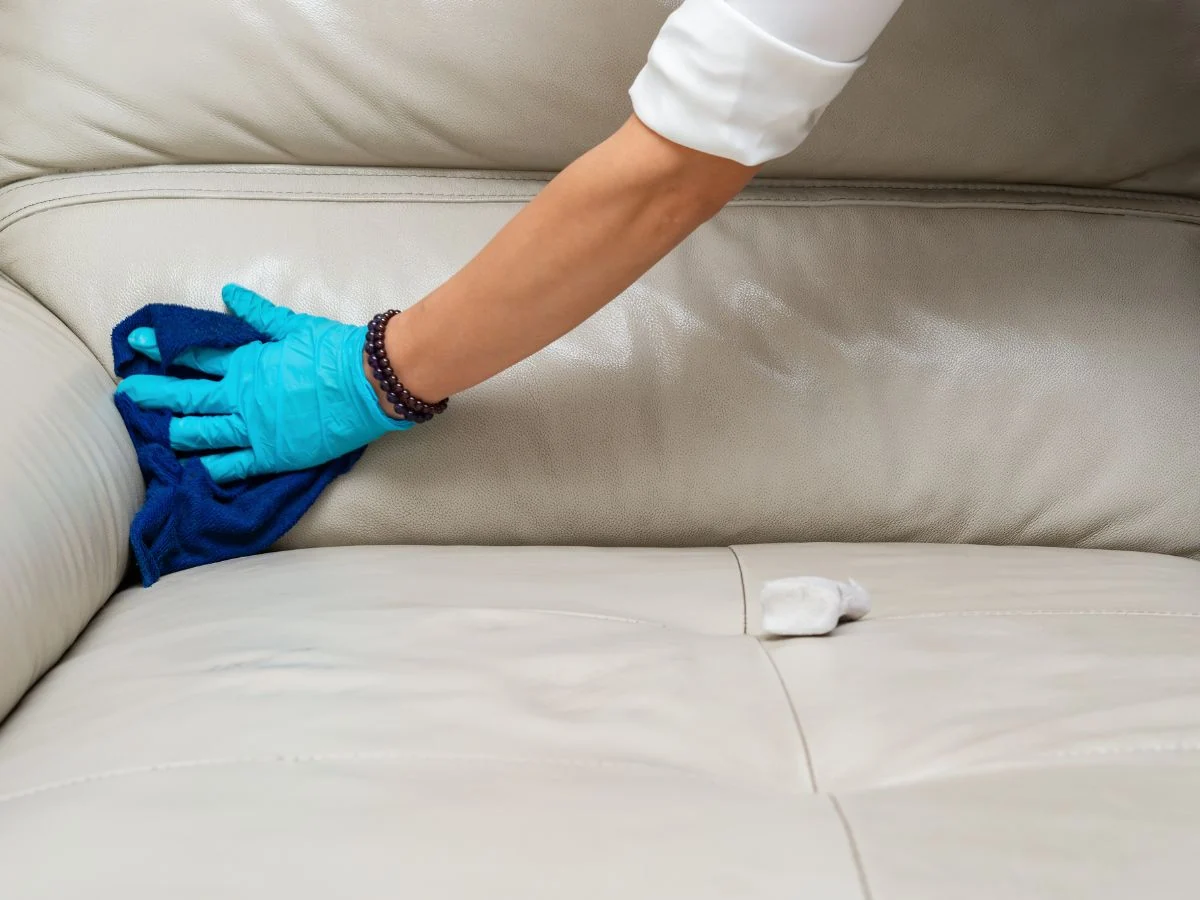How to remove pen marks from leather couch, it’s a common concern for homeowners who’ve invested in quality leather furniture. Finding a pen mark or ink stain on your leather couch, sofa, or other leather items can feel devastating. After all, a good leather couch often costs upwards of £1,000, making it one of your home’s most expensive pieces. The good news? Most pen marks can be removed safely and effectively with the right approach.
Acting quickly makes a huge difference, but even older stains can often be treated successfully. This guide covers proven methods for removing pen marks and ink stains from leather furniture, from household remedies to professional products, plus essential tips to protect your leather’s finish.
Understanding Different Types of Pen Marks
The type of ink stain determines which removal method works best and how challenging the cleaning process will be.
Understanding the specific type of ink stains from leather is crucial, as different inks may require different cleaning solutions or professional services. This knowledge helps you choose the safest and most effective way to remove ink stains from your leather items.
Ballpoint Pen Marks
Ballpoint pens use oil-based ink that sits relatively close to the surface rather than penetrating deeply. These are typically the easiest to remove from leather surfaces. The thick consistency means the ink often forms a layer on top rather than soaking in immediately, making it possible to remove ballpoint ink using gentle methods like rubbing alcohol, mild soap, or a Magic Eraser without damaging the leather.
Gel Pen and Felt-tip Marks
These typically use water-based pen ink that spreads more quickly and penetrates deeper into leather’s natural pores. They often require alcohol-based cleaning solutions and gentle handling to avoid pushing ink deeper or damaging the surface.
Permanent Marker Stains
Permanent markers use alcohol-based inks designed to resist removal, making them the most challenging, especially when the leather is stained by a permanent marker. Success depends on the stain’s age, leather type, and specific marker used. These typically require stronger solutions and multiple treatment attempts.
Essential Preparation
Testing in Hidden Areas
Always test your chosen cleaning solution in a completely hidden area first. Different leather types and finishes may respond differently to cleaning products. Apply a small amount and wait for it to dry completely, checking for colour changes, texture alterations, or finish damage.
Gathering Supplies
You’ll need clean white cotton cloths or paper towels, a dry paper towel for blotting, a lint free cloth for gentle cleaning, cotton buds for precise application, and a cotton ball for applying cleaning solutions. Protective gloves are recommended. Ensure good ventilation, especially with alcohol-based products. Having everything ready makes the process smoother and more effective.

Home Remedies for Pen Mark Removal
The Rubbing Alcohol Method
Rubbing alcohol is one of the most effective household solutions. Use 70% to 90% isopropyl alcohol applied to a clean cloth or a cotton swab for precise application, never directly onto leather. Gently dab from outside edges toward the centre to prevent spreading. After dabbing, gently blot the area with a clean, dry cloth to avoid spreading the stain and to maintain the leather’s integrity. Allow the alcohol to work for a few minutes, then blot with a clean, dry cloth. Repeat as needed without oversaturating. This method can help remove ink from leather surfaces.
Hairspray Technique
Alcohol-based hairspray can effectively remove pen marks, particularly fresh ballpoint ink. Spray onto a cloth and gently dab the mark. Avoid hairsprays with oils or fragrances that could stain. Clean with a damp cloth afterward to remove residue-this method can help remove stains from leather.
Milk and Soap Solution
For delicate leather, mix equal parts whole milk and mild liquid soap or moisturizing soap. This gentler approach works well on older or fragile leather. Apply with a soft cloth in circular motions, leave for several minutes, then wipe clean. May require multiple applications but is much safer for sensitive finishes.
Professional Leather Cleaning Products
Leather-Specific Stain Removers
Professional products like Leather Master, Furniture Clinic, and Colourlock are formulated specifically for leather care. These products are suitable for treating a variety of leather goods, such as leather car seats, leather items, and other delicate leather products. They typically cost £15-£30 but offer more powerful, targeted solutions with less damage risk. Follow manufacturer instructions carefully and ensure proper ventilation.
Conditioning After Cleaning
After removing stains, conditioning with a good leather conditioner is essential to restore moisture and flexibility. Using a good leather conditioner not only prevents cracking and maintains the natural appearance, but also helps restore the protective layer and preserve the leather’s finish. Apply after the leather has dried completely, covering the entire piece for uniform protection.
Step-by-Step Cleaning Process
Assessment and Application
Examine the ink marks or pen mark’s size, depth, and age. Fresh stains are easier to remove than set-in marks. Identify the pen type if possible. Start with the gentlest appropriate method, applying cleaning solution to cloth rather than directly to leather, aiming to remove ink stain and remove ink from leather effectively.
Proper Technique
Work from outside edges toward the centre using gentle dabbing motions. For stubborn stains, you may gently rub the area with a soft cloth and mild soap, but always use a non-abrasive motion to avoid damaging the surface. Never rub or scrub aggressively, as this can damage the surface or push ink deeper.
Different leathers, such as genuine leather and synthetic leathers, may require different techniques-real leather absorbs ink and moisture more readily, so extra care is needed. Work in small sections, allowing each area to dry before continuing. If the stain lightens, continue with the same method.
Drying and Conditioning
Allow natural air drying away from heat or sunlight, as longer stains are more difficult to remove if not dried promptly. Once completely dry, apply suitable leather conditioner to restore moisture, especially important after alcohol-based cleaning. The cleaned area should look and feel consistent with surrounding leather.
What NOT to Do
Never use excessive force, bleach, ammonia-based cleaners, nail polish remover, or abrasive materials. Don’t oversaturate leather or use hot water. Avoid fabric cleaners or excessive amounts of water. These mistakes can cause permanent damage, discolouration, or cracking, and may do more harm than good.

When to Call Professionals
Seek expert help for extensive staining, valuable antique pieces, or when DIY attempts have worsened the problem. Professionals are experienced in removing ink from leather and can safely restore your items. Professional services typically cost £100-£300 but often cost less than replacing damaged furniture. Look for experienced leather restoration specialists with good reviews and clear guarantees.
Prevention Tips
Protective Measures
Apply leather protector spray every six months to create a stain barrier. For regular cleaning and to help prevent stains, gently wipe the leather with a solution of equal parts white vinegar and water using a soft cloth. However, it’s important to understand why leather sofa cleaning is best left to experts for anything beyond basic maintenance, as improper techniques can cause permanent damage even with seemingly gentle home remedies.
Regular Maintenance
Dust weekly with a soft cloth and deep clean every 3-6 months. For regular upkeep, you can use a solution of white vinegar diluted with water as a gentle cleaning agent-apply it with a soft cloth and dab gently. Regular conditioning keeps leather supple and more resistant to staining. Address spills immediately before they set. Well-maintained leather is easier to clean when accidents occur.
Conclusion
Removing pen marks from leather couches is achievable with the right approach and patience. Understanding ink types, choosing appropriate methods, and working gently preserves your leather’s integrity. Quick action helps, but even older stains can often be successfully treated.
When cleaning, tools like a spray bottle for applying diluted cleaning solutions and a magic eraser (used with caution) can be effective for ink stain removal. However, avoid using nail polish removers, especially those containing acetone, as they can damage leather surfaces. Always test cleaning solutions first, start with gentle methods, and don’t hesitate to seek professional help for valuable pieces or stubborn stains. Regular maintenance and protective measures prevent most problems from occurring.
For stubborn pen marks that won’t budge or valuable leather furniture needing expert care, consider professional leather cleaning services. LeatherXpert offers specialist cleaning and restoration throughout the North East, including Newcastle, Northumberland, Durham, and surrounding areas. With over 30 years of experience and eco-friendly methods, they can safely remove challenging stains while preserving your leather’s quality and appearance. Contact us today to restore your leather to its best condition.
